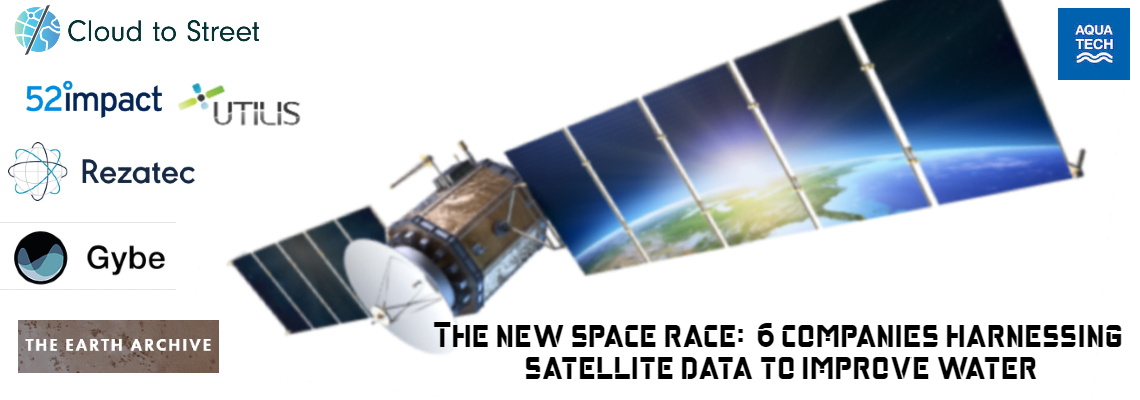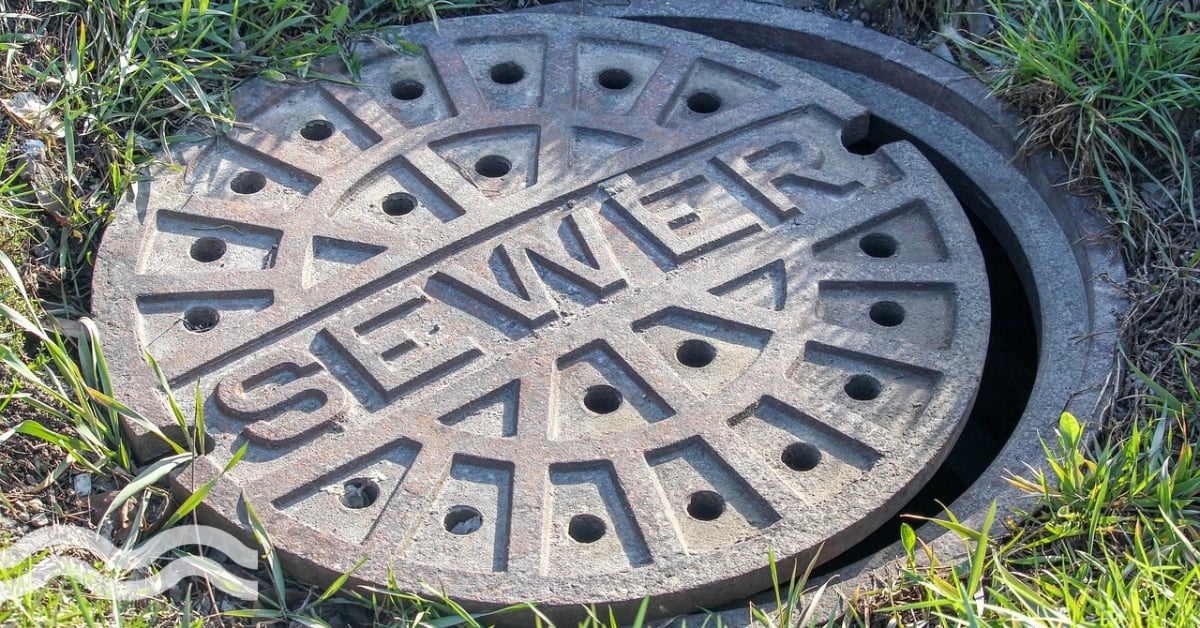The new space race: 6 companies harnessing satellite data to improve water
Earth Observation Science solutions in the water market are estimated to be worth £2 billion by 2027. We take a look into six companies applying satellite data to improve water.
Actionable data, from 30,000km
The use of satellites and Earth Observation Science (EOS) solutions are not new. Back in the 1970s, satellite data-enabled estimations of precipitation and weather.
Since then, the applications for EOS solutions have grown, and the water sector could benefit immensely.
From mapping water quantity at a country level, through to real-time water quality monitoring locally, satellites may be over 30,000 kilometres up in space, but they’re providing actionable data to help make decisions on the ground.
“For investors interested in a niche but fast-growing sub-segment of water, the emerging Satellite-sourced Data & Insights (SSDI) space is one of the more compelling opportunities,” said John Robinson, partner at Mazarine Ventures.
Speaking to Aquatech Online, he said: “More of a data science play than a ‘satellite’ play, the winners in this realm will have the capabilities to take satellite-sourced data, structure it, and through analytics turn it into actionable insights for high-value customer segments.”
In 2017, the market for EOS solutions was valued at $3.2 billion and is predicted to grow to just under $6 billion by 2027, according to BlueTech Research.
This includes applications across all sectors, from defence to maritime engineering. From this $6 billion, it’s estimated that the energy markets, including water applications, will be worth an estimated £2 billion by 2027.
“EOS technology solutions alone are not a game-changer for both the public and private sectors in managing water quality and quantity,” said Will Sarni, founder & CEO of Water Foundry.
He told Aquatech Online: “When coupled with other digital technologies such as AI, however, they create more resilient and sustainable water strategies across the “digital water value chain” – from the watershed, in operations and connecting with consumers.“The investment opportunities have accelerated during the pandemic and will continue as more traditional solutions can’t deliver the same value.”
Aqueduct Tool and Water Risk Filter
Two of the leading risk tools currently used by multinationals include the World Resources Institute (WRI) Aqueduct Tool and the World Wildlife Fund (WWF) Water Risk Filter.
The Water Risk Filter has continually undergone upgrades and improvements since it was launched in 2012.
Earlier this month, WWF added “Scenarios” to the tool, launched to help companies better understand future water risks. The platform can generate three scenarios (Optimistic, Current Trend and Pessimistic) for 2030 and 2050.
Meanwhile, Aqueduct, launched in 2011, is a collection of tools to help companies, governments and civil society understand and respond to water risks. This can include water stress, variability from season-to-season, pollution and water access. Since its launch, continual upgrades have been made.
Multiple companies now involved across four market categories: soil loss and erosion mapping; asset monitoring & maintenance; water quality monitoring, and flood prediction. Below are six examples of companies operating across these categories.
Soil loss and erosion mapping
1) 52impact
Founded in 2017, the Dutch-based technology company, 52impact’s tool – 52suite – uses a combination of GIS technology, image processing algorithms and machine learning to convert satellite and other spatial data into interactive maps.
Data monitoring includes nature & land restoration; water risk management; agriculture & trading and spatial planning & tourism. The organisation has partnered with the Waterwatch Cooperation, as well as BlackShore to commercialise combined gamification with crowdsourcing to map deforestation with satellite imagery.
Asset monitoring & maintenance
2) Utilis
The Israeli-based technology company, Utilis, has gathered momentum in the water utility space, focusing on leak detection. Founded in 2013, the organisation has secured 250 projects globally and is backed by private investors and venture capital firm, Maverick Ventures Israel.
The Utilis technique uses L-Band (1.3 gigahertz) synthetic aperture radar (SAR) data, a specific wavelength that it says can penetrate the ground. Satellite data, analysed using patented algorithms and SAR analytics, is used to detect treated water via spectral signal identification. To date, the organisation said it had identified 20,000 leaks.
A noteworthy development for the company is a shift from drinking water leak detection to sewer breaks. Out of the 250 projects, four are on sewer break detection in the UK, US, Thailand and China.
In a previous interview, CEO Elly Perets told Aquatech Online that Utilis plans to “offer the SAR solution across the utility corridor”.
"We are taking the same raw material and analysing it through two algorithms," he said. "One algorithm for treated water and one algorithm for sewage water.”
3) Rezatec
Founded in 2012, the UK company’s water SAT geospatial solution combines artificial intelligence (AI) analytics with historic and new satellite data. A combination of optical and radar satellites (Sentinel) is used to focus on four key areas: water utilities, forestry, agriculture and energy.
Water applications focus on infrastructure and catchment management, broken down into three further areas:
- Dam monitoring: tracking unusual deformation in dam and embankment infrastructure
- Pipeline risk for water networks: determining the highest risk of water pipeline failure across the network
- Water quality: monitoring how land use impacts water quality at a catchment level.
Utility customers to date include Maynilad Water in the Philippines, Portsmouth and Scottish Water in the UK, Kingston Water in Ontario, Canada, and Hunter Water in Australia.
The organisation announced an investment of £5 million in early February 2020 from Gresham House’s Baronsmead and Renewable Energy VCTs, as well as a strategic partnership with engineering consultancy, Black & Veatch.
Water quality monitoring
4) Gybe
US start-up Gybe combines on-the-ground sensors installed above the water, together with remote sensing imagery to provide real-time data to inform water management decisions. The company combines sensor and satellite data for a watershed overview of water quality.
Sensors measures under three categories, including:
- Biology – Chlorophyll-a Concentration and cyanobacteria
- Geo-Physical Parameters – Turbidity and sediment concentration
- Chemicals + Nutrients – Coloured, dissolved organic matter.
Gybe passed through the Techstars Sustainability Accelerator, in partnership with The Nature Conservancy. It was then one of AB InBev’s 100+ Sustainability Accelerator cohort in 2020, delivering an installation in June at the Palisades Reservoir in Idaho, US.
Since launching its pilot product a year ago, Gybe has fielded 10 systems across Oregon, Idaho, Mississippi, Louisiana, California and North Carolina.
Flood prediction
5) Cloud to Street
US start-up Cloud to Street was founded in 2018 with the mission to map the 100 most vulnerable watersheds. The organisation estimates flood risk by monitoring climate metrics, including rainfall, soil moisture and dam levels to identify communities at high risk of frequent flooding.
It combines streaming remote sensing, harnessing data from satellites, machine learning and community intelligence to dynamically map floods. Its online platform is called the Flood Risk Dashboard.
The organisation worked with the Democratic Republic of the Congo to create a remote flood monitoring system to help alert the government and UN of emergency flooding. The system led to the relocation of a refugee camp, after detecting early flood conditions along the Congo River.
6) The Earth Archive
The Earth Archive aims to scan the entire solid surface of the planet, starting with the areas most threatened, in the next decade. LiDAR (Light Detection & Ranging), will be used to map vegetation and the ground beneath it in three dimensions from the vantage point of a plane, helicopter or drone.
The Earth Archive team estimates that raw, LiDAR scanning of the entire planet's landmass can be achieved for US$5 billion, excluding data analysis costs. Currently, the team is identifying which areas should be prioritised.
Founder & director Chris Fisher describes the ambitions of the project in the video below:
Speaking to Aquatech Online, Fisher said: “We are initiating a crowd-funding campaign to scan the entire Amazon Basin. We believe this can be done for US$15-20 million in five years.”
What lidar data provides is not a flat image but instead, a dense, three-dimensional cloud of points recording the Earth's surface and everything on it.
Using computer software, researchers can filter the point cloud to identify features such as trees, geological fault lines, hydrological elements. Using 3D visualisation technologies, researchers can actually walk through the resulting “point cloud”.
- This article is based on an upcoming BlueTech Research report on Earth Observation Science. For more information, please visit here.
Related content
Loading component...
We promise never to send you spam and you can unsubscribe at any time!

.jpg?h=628&iar=0&w=1200)

